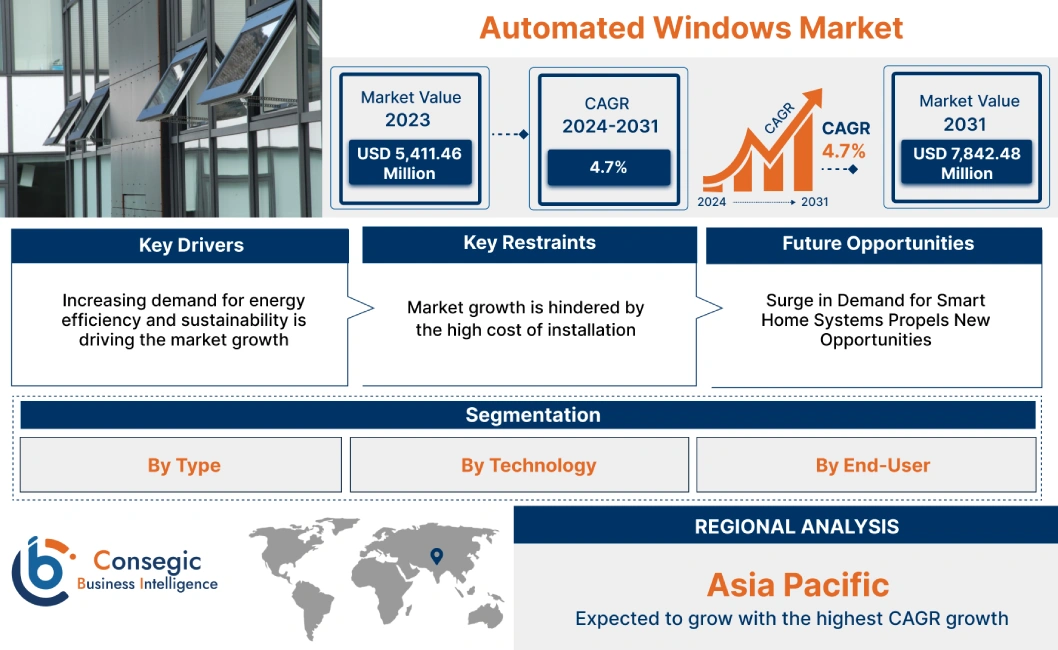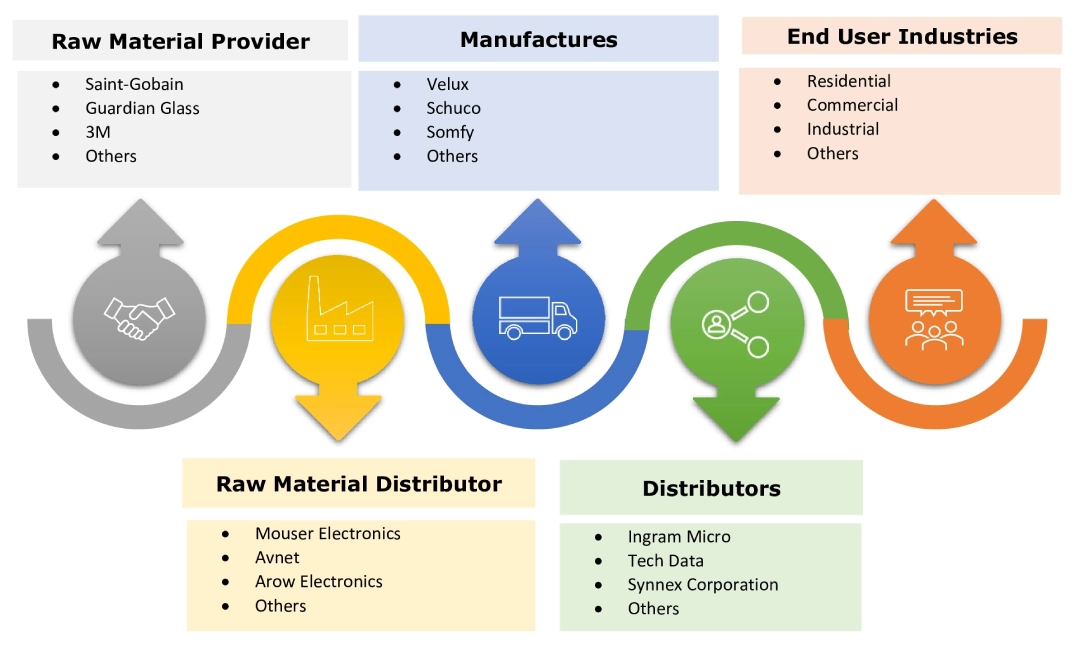- Summary
- Table Of Content
- Methodology
Automated Windows Market Size:
Automated Windows Market size is estimated to reach over USD 7,842.48 Million by 2031 from a value of USD 5,411.46 Million in 2023 and is projected to grow by USD 5,571.97 Million in 2024, growing at a CAGR of 4.7% from 2024 to 2031.
Automated Windows Market Scope & Overview:
Automated windows are windows that are equipped with smart technology, enabling them to open, close, and adjust automatically without manual intervention. These systems are controlled via remote controls, sensors, voice commands, or integration with smart home systems. Additionally, these windows are integrated with building automation systems, allowing for functions including temperature control, natural light optimization, and ventilation management, contributing to energy savings and improved comfort. Moreover, the benefits of these systems include convenience enhancement and energy efficiency in the residential, commercial, and industrial sectors. The aforementioned benefits of these windows are major determinants for increasing their deployment in the residential sector.
Automated Windows Market Insights:
Key Drivers:
Increasing demand for energy efficiency and sustainability is driving the market growth
Automated window is designed to optimize natural light and ventilation, which reduces the reliance on artificial lighting and air conditioning. By automatically adjusting, based on factors like time of day, weather conditions, or occupancy, these systems help lower energy consumption. Additionally, as energy efficiency becomes a top priority for both consumers and businesses, the appeal of these windows continues to grow, making them a popular choice in modern building designs.
- In December 2021, View, Inc. introduced smart windows installation at Bozeman Yellowstone International Airport (BZN) which automatically adjusts tint based on external light conditions, reducing energy usage by minimizing the need for artificial lighting and air conditioning.
Therefore, the rising trend for energy efficiency among consumers is proliferating the automated windows market demand.
Key Restraints :
Market growth is hindered by the high cost of installation
The initial investment required is substantial, encompassing the windows and the integration of control systems. This high cost acts as a barrier to widespread adoption, particularly in residential applications where budget constraints are more pronounced. In addition to initial costs, the ongoing maintenance and potential repair expenses associated with these windows further contribute to industry restraint. These additional financial considerations make automated windows less appealing to budget-conscious consumers and businesses.
- For instance, High-end automated windows generally start from a price range of around $1,500 to $2,000 per unit or per square meter. This price can increase significantly depending on the specific brand, customization options, materials used, and the complexity of the automation features. Premium brands including Sky-Frame, VELUX, Vitrocsa, and Crittall often fall within this range, catering to luxury residential and commercial projects where advanced technology and design are paramount.
Hence, as per the analysis, the high initial cost of installation and maintenance is restricting the automated windows market trend.
Future Opportunities :
Surge in Demand for Smart Home Systems Propels New Opportunities
The automated windows market is experiencing robust growth. It is largely fueled by the increasing adoption of smart home technologies. As consumers seek to enhance their living environments with advanced features, these windows are becoming key components in modern smart homes. Additionally, these windows offer a range of benefits, including improved convenience, enhanced controls, customization, interoperability, and security.
- In August 2023, Crestron Electronics launched Crestron Home OS 4, a smart home system, featuring customization, interoperability, home control using a remote, touchscreen keypad or mobile device, security, and privacy.
Therefore, as per the analysis, the increasing need for automated windows in smart home systems is fueling the global automated windows market opportunities.
Automated Windows Market Segmental Analysis :
By Type:
Based on the type, the market is bifurcated into Fully Automatic and Semi-Automatic.
Trends in the type:
- Semi-automated windows are seeing a growing trend towards more customizable features, enabling homeowners to manually adjust settings while benefiting from some level of automation.
- The trend towards touchless operation is growing particularly in public and commercial sectors, where fully automated windows can be controlled via gestures or sensors.
The semi-automatic type segment accounted for the largest revenue share in the year 2023.
- Semi-automatic windows combine manual operation with basic automation features, including motorized opening and closing controlled by switches or remotes.
- These windows allow more customization according to individual preferences and specific building requirements.
- Factors including cost-effectiveness, ease of installation, energy efficiency, and scalability further drive the segment.
- In March 2023, VELUX unveiled Roof Window, a semi-automated system, crafted from recycled materials, that effectively decreases their embodied carbon footprint in contrast to regular VELUX blinds.
- Thus, the customization and energy efficiency of semi-automated windows are collectively boosting the automated windows market growth.
The fully automatic type segment is anticipated to register the fastest CAGR during the forecast period.
- Fully automatic windows are equipped with advanced mechanisms that allow windows to open, close, and function based on various sensors, timers, or automated controls.
- These windows include sensors for temperature, humidity, and sunlight, allowing them to adjust automatically based on environmental conditions.
- In February 2022, Lutron Electronics launched Serena Smart Architectural Honeycomb Shades, with automated window shades that adjust based on sunlight and temperature. It also works seamlessly with smart home ecosystems.
- Therefore, as per the automated windows market analysis, the sensors in fully automatic windows adjust according to the sunlight and temperature are anticipated to drive the automated windows market opportunities.
By Technology:
Based on technology the market is segmented into Sensor-based, Remote-Controlled, and Voice-Controlled.
Trends in the technology:
- Advances in remote-controlled systems are enabling users to control multiple windows simultaneously, improving overall management and convenience.
- There is a growing tendency towards sensor-based systems to optimize energy usage including adjusting windows to enhance natural ventilation and reduce heating and cooling costs.
The remote-controlled technology segment accounted for the largest revenue share of 46.21% in 2023.
- Remote-controlled windows offer ease of use by allowing you to adjust window settings through remotes or smartphones.
- These windows are increasingly being integrated with Smart Home ecosystems, enhancing functionality and user experience.
- In July 2022, Somfy launched Tahoma Gateway, a system providing remote control for windows and shades. The solution integrates seamlessly with smart home technologies including Control 4, Crestron, CrestronHome, Brilliant, Savant, Elan, URC, and RTI.
- Hence, the ability of remote-controlled windows to provide flexibility to adjust the window setting, is proliferating the automated windows market trend.
The controlled technology segment is anticipated to register the fastest CAGR during the forecast period.
- Voice control offers a convenient, hands-free way to operate and adjust Windows settings.
- It provides an intuitive and natural way to interact with automated systems, enhancing user experience.
- Determinants including accessibility, enhanced user experience, advanced customization, and increased convenience.
- In November 2023, Hunter Douglas introduced the PowerView Gen-3 Automation system, enabling users to control window treatments using voice commands, with Bluetooth Low Energy wireless technology.
- Consequently, as per the analysis the aforementioned benefits of voice-controlled windows are driving the automated windows market demand.
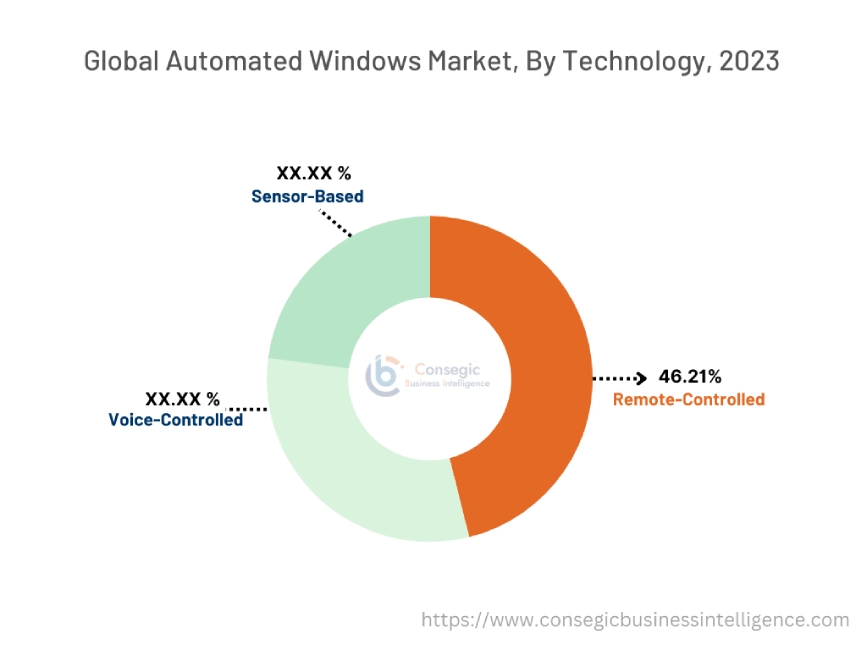
By End-User:
Based on end-user, the market is segmented into Residential, Commercial, Industrial, and others.
Trends in the end-user:
- In industrial settings, automated windows are being used to enhance energy management by regulating the indoor environment, which is crucial in manufacturing and storage facilities.
- There has been an increasing trend of integrating automated windows with Building Management Systems (BMS) for better control, energy management, and monitoring across large commercial properties.
The residential segment accounted for the largest revenue share in the year 2023 and is anticipated to register the fastest CAGR during the forecast period.
- The dominance is driven by an increasing adoption of smart home technologies, energy efficiency initiatives, and the growing demand for convenience.
- In April 2022, JELD-WEN introduced a new line of Auraline composite windows and patio doors. Designed to fill a significant need for home building products, offering a creative solution for the increasing sustainable building material.
- Therefore, according to analysis, the rising need for smart home technologies in residential buildings is boosting the automated windows market share.
Regional Analysis:
The regions covered are North America, Europe, Asia Pacific, Middle East and Africa, and Latin America.
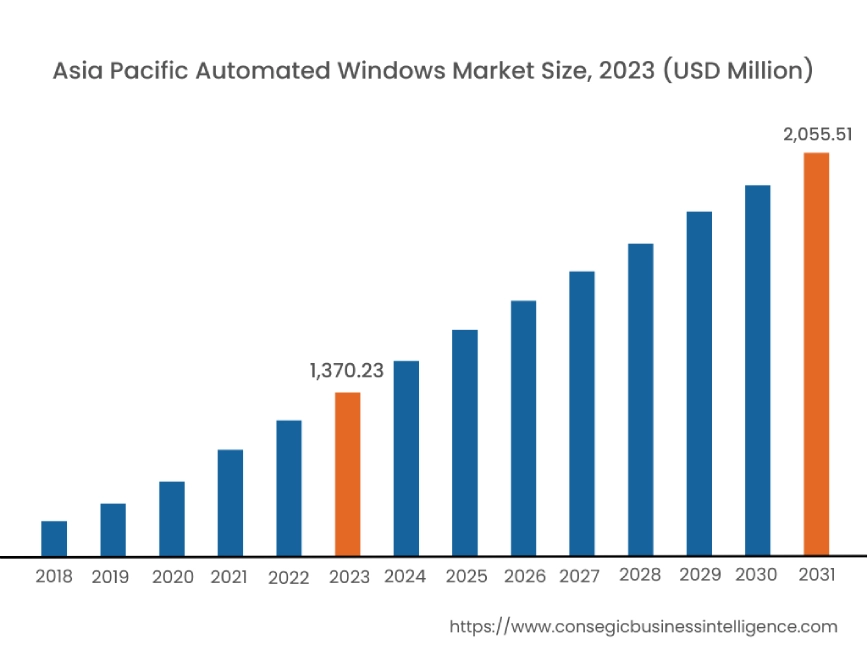
Asia-Pacific region was valued at USD 1,370.23 Million in 2023. Moreover, it is projected to grow by USD 1,415.00 Million in 2024 and reach over USD 2,055.51 Million by 2031. Out of this, China accounted for the maximum revenue share of 35.9%. As per the analysis, the automated windows market has seen fast growth due to urbanization, economic development, and increasing knowledge about energy efficiency. In this aspect, China, India, and Japan are among the nations making big leaps by investing heavily in infrastructure and real estate projects. On the other hand, one of the driving forces behind automated window technologies is the high demand for contemporary energy. Additionally, smart window systems that use dynamic tinting and remote-control functions in their designs have started becoming a norm for business as well as domestic buildings.
- In October 2021, Saint-Gobain India revealed a unique 'Myhome' brand store in Mumbai. Saint-Gobain now provides complete solutions using a range of its products like Shower Cubicles, Windows, Kitchen Shutters, and more. Mumbai, known for having one of the priciest real estate markets in India, saw a rise in the housing industry with a 29% surge in 2021. Because of the ongoing rise in property registrations, homeowners are eager to utilize innovative and personalized options that improve the aesthetics of their homes.
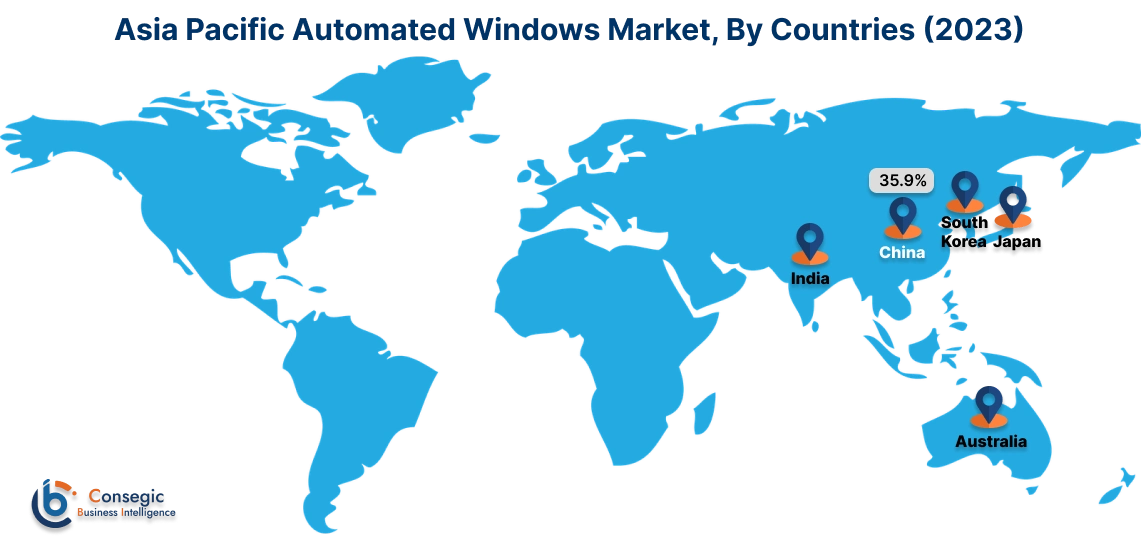
North America is estimated to reach over USD 2,668.01 Million by 2031 from a value of USD 1,860.33 Million in 2023 and is projected to grow by USD 1,913.84 Million in 2024. The automated Windows market is thriving in North America due to the widespread adoption of intelligent systems along with well-developed infrastructure that prompts innovation. The United States of America and Canada are among the pioneers in integrating these window systems into their homes, offices, and factories. This growth is driven by a strong emphasis on energy efficiency as well as sustainability both, countries have established stringent regulations and incentives to encourage green building practices. This has been driven by the ever-increasing demand for smart building solutions that engender convenience while reducing energy consumption.
- In June 2023, Johnson Controls launched its newest automated window systems which have been designed to better integrate with building management systems. These windows are currently being installed across various high-profile projects in North America such as office buildings and smart campuses noted the press release. The main aim of this technology is to improve energy efficiency and ensure a seamless user experience through advanced automation and connectivity.
Latin America is improving its lucrative automated windows market supported by urbanization growth, economic increase, and shifts towards modern house solutions. Brazil, Mexico, and Chile are key examples where people are growing more interested in automated window technologies as they try to make buildings better in terms of effectiveness and coziness.
The automated windows market in the Middle East and Africa is gradually expanding, driven by rapid urbanization, increased infrastructure investment, and a growing emphasis on luxurious and energy-efficient building solutions.
Countries such as UAE, Saudi Arabia, and South Africa lead in integrating automated window technologies into high-end residential, commercial, and hospitality projects. The region's focus on smart cities and sustainable development is fostering advanced technologies including automated windows with attributes such as dynamic tinting and remote-control features to improve energy efficiency and indoor comfort.
Top Key Players & Market Share Insights:
The automated windows market is highly competitive with major players providing automated systems to the national and international markets. Key players are adopting several strategies in research and development (R&D), product innovation, and end-user launches to hold a strong position in the automated Windows market. Key players in the automated windows industry include-
- Velux Group(Denmark)
- SageGlass (US)
- Somfy (France)
- Breezway (Australia)
- Colt International (U.K.)/li>
- D+H Mechatronic (Germany)
- ASSA ABLOY (Sweden)
- Nabtesco Corporation (Japan)
- Allegion Plc (Ireland)
- Sky-Frame (Switzerland)
- Schuco International (Germany)
- EBSA (Argentina)
- Geze (Germany)
- Gira (Germany)
- Insteon (U.S.)
- JLC Automation Services (U.K.)
- Kintrol (Australia)
- Dormakaba Group (Switzerland)
Recent Industry Developments :
Product Launch:
- In January 2024, Pella Corporation unveils current design trends, showing how windows and doors can play a key role in personalizing living spaces. Environmentally friendly construction techniques and materials, as well as expert workmanship and efficient windows and doors, enhance the home experience with efficiency.
- In June 2023, Guardian Glass released a new product line featuring electrochromic technology that allows windows to transition from transparent to tinted based on light conditions. This product is designed for both residential and commercial applications, promoting energy savings and occupant comfort.
- In January 2023, Vision Saint-Gobain launched a new range of smart windows with enhanced self-cleaning capabilities and improved thermal insulation. The windows use advanced nanotechnology to repel dirt and optimize energy efficiency, targeting high-end residential and commercial markets.
Business Expansion:
- In December 2023, SOMFY Group, implemented its 2030 Ambition strategic plan by prioritizing CSR and digitalization at the heart of the company, within its Executive Committee.
Business Investment:
- In May 2024, Skyline Windows revealed a strategic investment from Schueco International, a worldwide specialist in windows, doors, and façade solutions. Schueco is acquiring a small share of ownership in Skyline, promoting a dynamic interchange of technology and expertise. Skyline will be the sole distributor of Schueco's products in North America, incorporating Schueco's cutting-edge solutions into its own wide-ranging projects business.
Automated Windows Market Report Insights :
| Report Attributes | Report Details |
| Study Timeline | 2018-2031 |
| Market Size in 2031 | USD 7,842.48 Million |
| CAGR (2024-2031) | 4.7% |
| By Type |
|
| By Technology |
|
| By End-User |
|
| By Region |
|
| Key Players |
|
| North America | U.S. Canada Mexico |
| Europe | U.K. Germany France Spain Italy Russia Benelux Rest of Europe |
| APAC | China South Korea Japan India Australia ASEAN Rest of Asia-Pacific |
| Middle East and Africa | GCC Turkey South Africa Rest of MEA |
| LATAM | Brazil Argentina Chile Rest of LATAM |
| Report Coverage |
|
Key Questions Answered in the Report
What is Automated Windows? +
Automated windows are windows that are equipped with smart technology, enabling them to open, close, and adjust automatically without manual intervention. These systems are controlled via remote controls, sensors, voice commands, or integration with smart home systems.
How big is the Automated Windows market? +
Automated Windows Market size is estimated to reach over USD 7,842.48 Million by 2031 from a value of USD 5,411.46 Million in 2023 and is projected to grow by USD 5,571.97 Million in 2024, growing at a CAGR of 4.7% from 2024 to 2031.
What is the key market trend? +
There has been an increasing trend of integrating automated windows with Building Management Systems (BMS) for better control, energy management, and monitoring across large commercial properties.
